Related Research Articles

Chicano, Chicana, is an identity for Mexican Americans who have a non-Anglo self-image. Chicano was originally a classist and racist slur used toward low-income Mexicans that was reclaimed in the 1940s among youth who belonged to the Pachuco and Pachuca subculture. In the 1960s, Chicano was widely reclaimed in the building of a movement toward political empowerment, ethnic solidarity, and pride in being of indigenous descent. Chicano developed its own meaning separate from Mexican American identity. Youth in barrios rejected cultural assimilation into whiteness and embraced their own identity and worldview as a form of empowerment and resistance. The community forged an independent political and cultural movement, sometimes working alongside the Black power movement.
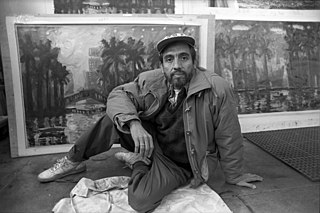
Carlos D. Almaraz was a Mexican-American artist and a pioneer of the Chicano art movement.

Gronk, born Glugio Nicandro, is a Chicano painter, printmaker, and performance artist. His work is collected by museums around the country including the Smithsonian American Art Museum.
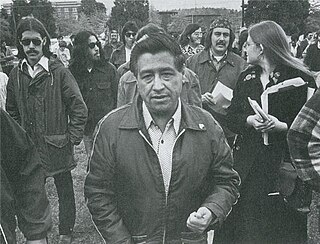
The Chicano Movement, also referred to as El Movimiento, was a social and political movement in the United States inspired by prior acts of resistance among people of Mexican descent, especially of Pachucos in the 1940s and 1950s, and the Black Power movement, that worked to embrace a Chicano/a identity and worldview that combated structural racism, encouraged cultural revitalization, and achieved community empowerment by rejecting assimilation. Before this, Chicano/a had been a term of derision, adopted by some Pachucos as an expression of defiance to Anglo-American society. With the rise of Chicanismo, Chicano/a became a reclaimed term in the 1960s and 1970s, used to express political autonomy, ethnic and cultural solidarity, and pride in being of Indigenous descent, diverging from the assimilationist Mexican-American identity. Chicanos also expressed solidarity and defined their culture through the development of Chicano art during El Movimiento, and stood firm in preserving their religion.

Chicana feminism is a sociopolitical movement, theory, and praxis that scrutinizes the historical, cultural, spiritual, educational, and economic intersections impacting Chicanas and the Chicana/o community in the United States. Chicana feminism empowers women to challenge institutionalized social norms and regards anyone a feminist who fights for the end of women's oppression in the community.
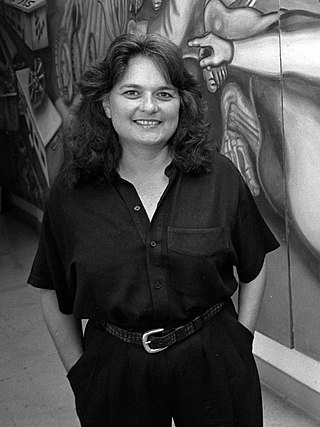
Judith Francisca Baca is an American artist, activist, and professor of Chicano studies, world arts, and cultures based at the University of California, Los Angeles. She is the co-founder and artistic director of the Social and Public Art Resource Center (SPARC) in Venice, California. Baca is the director of the mural project that created the Great Wall of Los Angeles, which is the largest communal mural project in the world.

Chicano poetry is a subgenre of Chicano literature that stems from the cultural consciousness developed in the Chicano Movement. Chicano poetry has its roots in the reclamation of Chicana/o as an identity of empowerment rather than denigration. As a literary field, Chicano poetry emerged in the 1960s and formed its own independent literary current and voice.
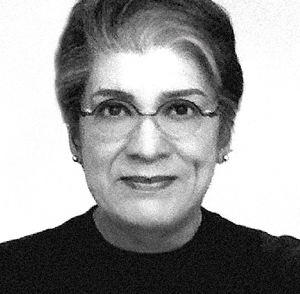
Judithe Hernández is an American artist and educator, she is known as a muralist, pastel artist, and painter. She a pioneer of the Chicano art movement and a former member of the art collective Los Four. She is based in Los Angeles, California and previously lived in Chicago.

The Chicano Art Movement represents groundbreaking movements by Mexican-American artists to establish a unique artistic identity in the United States. Much of the art and the artists creating Chicano Art were heavily influenced by Chicano Movement which began in the 1960s.
Willie Herrón III is an American Chicano muralist, performance artist and commercial artist.
Laura Aguilar was an American photographer. She was born with auditory dyslexia and attributed her start in photography to her brother, who showed her how to develop in dark rooms. She was mostly self-taught, although she took some photography courses at East Los Angeles College, where her second solo exhibition, Laura Aguilar: Show and Tell, was held. Aguilar used visual art to bring forth marginalized identities, especially within the LA Queer scene and Latinx communities. Before the term Intersectionality was used commonly, Aguilar captured the largely invisible identities of large bodied, queer, working-class, brown people in the form of portraits. Often using her naked body as a subject, she used photography to empower herself and her inner struggles to reclaim her own identity as “Laura”- a lesbian, fat, disabled, and brown person. Although work on Chicana/os is limited, Aguilar has become an essential figure in Chicano art history and is often regarded as an early "pioneer of intersectional feminism” for her outright and uncensored work. Some of her most well-known works are Three Eagles Flying, The Plush Pony Series, and Nature Self Portraits. Aguilar has been noted for her collaboration with cultural scholars such as Yvonne Yarbo-Berjano and receiving inspiration from other artists like Judy Dater. She was well-known for her portraits, mostly of herself, and also focused upon people in marginalized communities, including LGBT and Latino subjects, self-love, and social stigma of obesity.
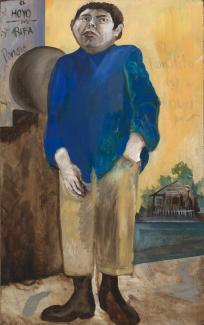
Roberto Chavez is an American artist. known for his personally symbolic portraits, public murals and "funny-grotesque" paintings that reflect the multicultural landscape of Los Angeles. He was recently included in the Getty Center's Pacific Standard Time: Art in L.A., 1945-1980 and the Smithsonian’s Our America: The Latino Presence in American Art exhibits.
Yreina Cervantez is an American artist and Chicana activist who is known for her multimedia painting, murals, and printmaking. She has exhibited nationally and internationally, and her work is in the permanent collections of the Smithsonian American Art Museum, The Mexican Museum, the Los Angeles County Museum, and the Los Angeles Museum of Contemporary Art.
Chicano Art: Resistance and Affirmation was a traveling exhibit of Chicano/a artists which toured the United States from 1990 through 1993. CARA visited ten major cities and featured over 128 individual works by about 180 different Chicano/a artists. The show was also intended to visit Madrid and Mexico City. CARA was the first time a Chicano exhibit received major attention from the press and it was the first exhibit that collaborated between Chicanos and major museums in the U.S. The show was considered a "notable event in the development of Chicano art." Another unique feature of CARA was the "extensive planning" that attempted to be as inclusive as possible and which took place more than five years prior to the opening at Wight Art Gallery.
Barbara Carrasco is a Chicana artist and activist who lives and works in Los Angeles. She is a painter and a muralist. Her work critiques dominant cultural stereotypes involving socioeconomics, race, gender and sexuality, and she is considered to be a "radical feminist." Her art has been exhibited nationally and internationally. Her work was exhibited in the 1990-1993 traveling exhibition Chicano Art: Resistance and Affirmation.

América Tropical is a 98-foot wide fresco mural created in 1932 by David Alfaro Siqueiros and other artists in Los Angeles, California, on a second-level exterior wall of the Italian Hall. It was painted over soon after its completion on an external wall of the Italian Hall on Olvera Street, in El Pueblo de Los Angeles Historical Monument of Downtown Los Angeles. It was restored and revealed to the public in 2012, 80 years to the day after its first unveiling.
Gloria Graciela Gallardo was a Chicana activist and former religious sister. She is best known for her involvement in the 1970 student boycotts in Houston, coordinating the huelga schools and for co-founding Las Hermanas.

Chicana art as a specific genre emerged as part of the Chicano Movement of the 1960s and used art to express political and social resistance. Through different art mediums both past and contemporary, Chicana artists explore and interrogate traditional Mexican-American values and embody feminist themes through different mediums including murals, painting, photography, and more. The momentum created from the Chicano Movement spurred a Chicano Renaissance among Chicanas and Chicanos. Political art was created by poets, writers, playwrights, and artists and used to defend against their oppression and societal marginalization. During the 1970s, Chicana feminist artists differed from their Anglo-feminist counterparts in the way they collaborated. Chicana feminist artists often utilized artistic collaborations and collectives that included men, while Anglo-feminist artists generally utilized women-only participants.
Margaret Garcia is a Chicana muralist, educator, and arts-advocate based in Los Angeles.
Graciela Carrillo is a Chicana artist and muralist in San Francisco and member of the all-female Chicana/Latina artist group Mujeres Muralistas. She is a co-founder of Galería de la Raza, a gallery utilized to showcase the everyday lives of the Chicano community through art during the Chicano Civil Rights movement through the Chicano muralist movement.
References
- ↑ Fuentes, Ed (30 August 2012). "Monthly Mural Wrap: A Dozen Tags for August, 2012". KCET . Archived from the original on 29 September 2017. Retrieved 25 September 2017.
- 1 2 3 4 Borden, Tessie (16 June 2012). "Josefina Quezada: A Lifetime of Fighting for Public Art". The Autry Blog. Autry National Center of the American West. Archived from the original on 4 April 2015. Retrieved 27 March 2015.
- 1 2 3 4 Carillo, Eduardo (13 June 2005). "Segunda bienal de mujeres fotografas" (PDF). Graceta University (in Spanish). Retrieved 25 September 2017.
- ↑ Davidson, Terry (1982-11-07). "Spartans of Legend CV High Mural". Chula Vista Star-News. p. 12. Retrieved 2017-09-24– via Newspapers.com.
- ↑ "Josefina Quezada". Mural Conservancy of Los Angeles. Archived from the original on 22 April 2017. Retrieved 25 September 2017.
- ↑ Treviño, Jesús Salvador (2001). Eyewitness: A Filmmaker's Memoir of the Chicano Movement . Houston, Texas: Arte Publico Press. pp. 214. ISBN 9781611921434.
josefina quezada mural.
- 1 2 3 Mesinas, Samuel (7 June 2005). "Josefina Quezada recibe hoy homenaje". El Universal (in Spanish). Retrieved 2017-09-25.
- ↑ Wilson, William (1975-06-23). "Chicana Artists Still Seeking Idenfication". The Los Angeles Times. p. 49. Retrieved 2017-09-24– via Newspapers.com.
- ↑ Davalos, Karen Mary (2017-07-25). Chicana/o Remix: Art and Errata Since the Sixties. NYU Press. p. 60. ISBN 9781479849505.
- ↑ "Tree of Knowledge (aka Read)". CultureNOW. Retrieved 2017-09-25.
- ↑ Barnet-Sanchez, Holly; Drescher, Tim; Ybarra-Frausto, Tomás (2016). Give Me Life: Iconography and Identity in East LA Murals. Albuquerque, New Mexico: University of New Mexico Press. pp. 238, 240. ISBN 9780826357489 – via Project MUSE.
- ↑ "Restoring 'Tree of Knowledge' - 2012". SPARCinLA. Retrieved 2017-09-25.
- ↑ Davidson, Terry (1982-11-07). "Spartans of Legend CV High Mural". Chula Vista Star-News. p. 1. Retrieved 2017-09-24– via Newspapers.com.
- ↑ Branscomb, Max (1983-05-12). "Chicano Artists Paint Murals and Politics". Chula Vista Star-News. p. 7. Retrieved 2017-09-24– via Newspapers.com.